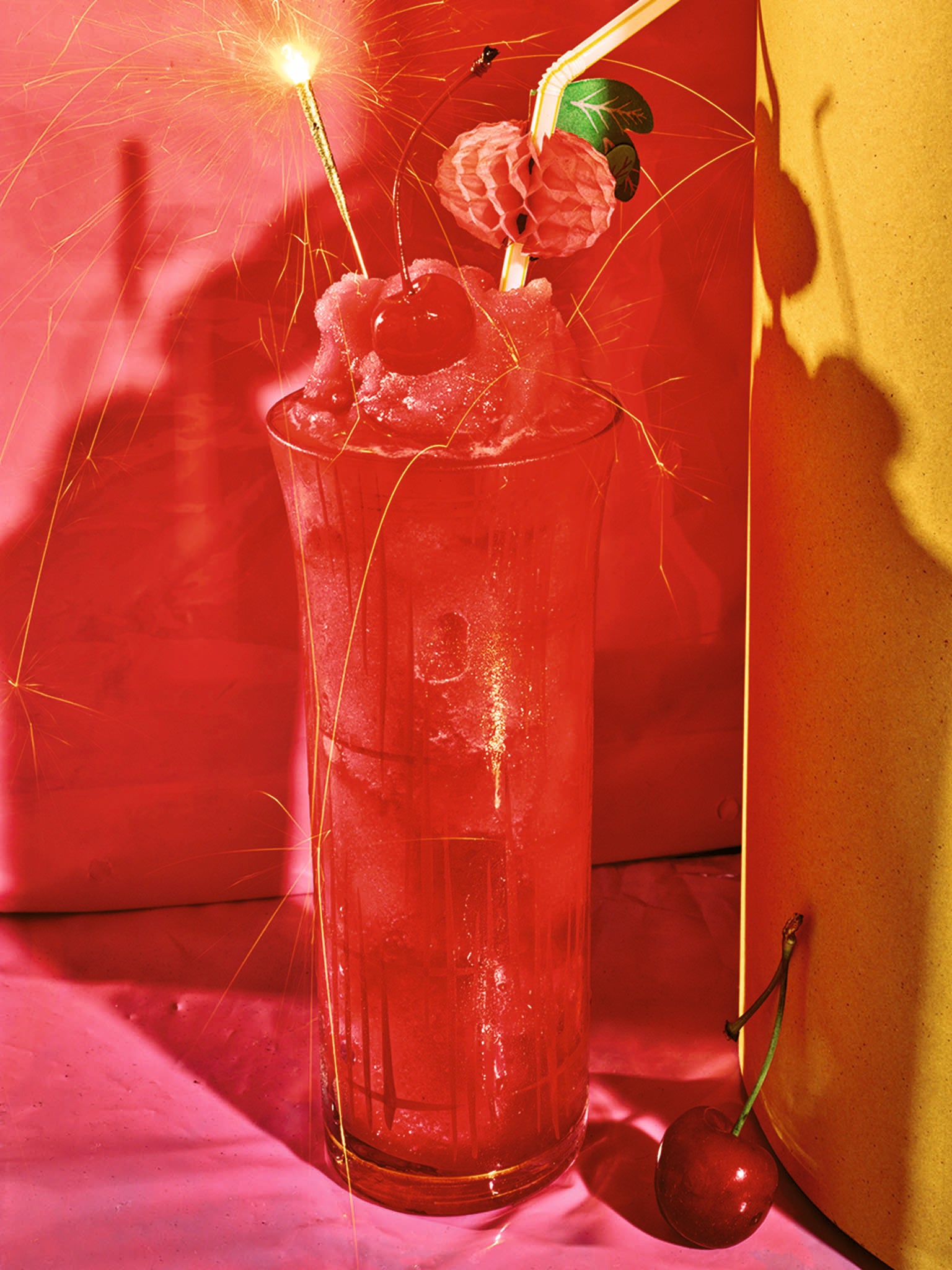How La Grotta Ices transformed the way we see ice cream
For 13 years, Kitty Travers has been bending the rules of ice cream making. Instead of bog standard neapolitan, she creates seasonal flavours from Amalfi lemon jelly to rhubarb and angelica

Kitty Travers keeps notebooks filled with recipes of every ice cream she’s made during the past 13 years. The pages are creased and carry splotches of custard, all marks of her frozen creations.
The notebooks chart successes, including her wildly popular cucumber and sour cream flavour, as well as the occasional failure, such as the time she learned that her much anticipated lily of the valley-flavoured ice cream was actually poisonous.
But mostly, they record how she’s perfected the ice creams she sells to adoring fans of La Grotta Ices, at the Spa Terminus farmer’s market in London and in a few select shops.
Now would-be ice cream makers can try their hand at making her unique takes on frozen treats, in her new recipe book, La Grotta Ices.
Her flavours are hardly what you’d find in the supermarket aisle. “I don’t make what’s popular, I make what I like making,” she says.
So forget bog standard vanilla and chocolate and think instead blackberry and rose geranium or tomato and white peach – flavours that are based on seasonal ingredients, with less sugar than you’d find in other ice creams.
The extra scoop
On 22 September 1942 Winston Churchill wrote a letter to Lord Woolton, the mastermind behind wartime rationing. Churchill was clearly not pleased. The reason? Woolton hadn’t consulted the cabinet before prohibiting the manufacture and sale of ice cream. Churchill mused that American troops would make “their own arrangements” adding that “They are great addicts of ice cream, which is said to be a rival to alcoholic drinks.
It’s a story included in the book Ice Creams, Sorbets and Gelati: The Definitive Guide by Caroline and Robin Weir. It’s a story near to Robin’s heart since he didn’t take his first lick of ice cream until 1946. “It was absolutely incredible. As a child I had never had anything like that – the idea of something that was cold but you put it in your mouth and it melted,” he says
It was also the beginning of a lifelong obsession and a collection he and Caroline Weir amassed of 14,000 ice cream-related paraphernalia, some of which he’s loaned to SCOOP: A Wonderful Ice Cream World, an exhibit launched by The British Museum of Food at Gasholders London, Kings Cross. SCOOP aims to bring ice cream to life so expect to sample glow-in-the-dark ice cream, learn about the neuroscience behind our favourite frozen food, and discover ice cream’s dark side
SCOOP: A Wonderful Ice Cream World through 30 September 2018 (bmof.org
Ice Creams, Sorbets & Gelati: The Definitive Guide by Caroline and Robin Weir is published by Grub Street Press
She got her start selling her ice cream at the Islington farmer’s market in the capital where she had to use ingredients grown near the capital. “So that meant no coffee, no chocolate, no vanilla,” she says. What others might find restrictive, Travers found liberating. She remembers finding peaches in the summer that weren’t quite ripe, “but they had leaves attached so I used to buy bags of peach leaves and use them to flavour the custards,” she says.
The leap wasn’t too difficult for Travers in part because she’d worked as a pastry chef at Spitalfields restaurant St John Bread and Wine where British ingredients form the backbone of the menu. When she started making her own ice creams, she found herself experimenting with ingredients like fig leaves. “These aren’t new flavourings, they’re just flavourings you can’t get in the supermarket.”
She also counts her time working at London’s Poilane bakery as influencing the way she thinks about food. Travers remembers how she’d have to convince customers that it was worth paying almost £6 for a loaf of sourdough bread, and how Leon Poilane refused to diversify and do “sausage rolls and pizza”. “It definitely fed into what I do and when I have wobbly moments it makes me think, no, it’s ok to do what you’re doing and trying to do well.”
What Travers wants is to get people to think about ice cream differently. “People are more used to the taste of processed food than natural foods so it takes a bit of adjusting your taste buds to get used to it.” Scan a list of ingredients for one of Travers ice creams and it’s all reassuringly familiar: milk, cream, eggs and seasonal fruit with nary a stabiliser or emulsifier to be seen.
Now Travers wants to encourage ice cream aficionados to try their hand at making ice cream. She’s been teaching ice cream making at the School of Artisan Food for around seven years, which has shown her where budding ice cream makers can run into trouble. “There really are no secrets. It’s just attention to what you’re doing and a little bit of applying a few tips that I’ve learned along the way about how to get the best flavour. And how to enjoy making it a bit more.”
When she started La Grotta Ices, Travers closed shop during the winter and spent time travelling in search out new ice creams and artisan ice cream producers. Countries like Italy, with their passeggiata, and France have long connections to the leisurely enjoyment of ice cream but so do surprising places like Iceland where the long summer days are spent outdoors with an ice cream or two. “Now it’s like their national food, like curry is in Britain,” she says.
As her business has grown, Travers finds herself making more ice cream year round. But she still finds time to travel, including a jaunt to Europe in January or February to take advantage of the citrus harvest. “I bring back weird collections of citrus in my suitcase and candy them so at least I’ve got them for the year to last me.”
But one of the beauties of Travers’s ice creams is that her menu is constantly changing based on what’s in season. Once they’re gone, they’re gone. So if you’re in London, enjoy her Amalfi lemon jelly in January and rhubarb and angelica in May, but if you’re not, make it yourself. “There is nothing as fun as pouring liquid into an ice cream machine and then 20 minutes later eating ice cream out of it. It never fails to be a joy.”

Passion fruit sour
Passion fruits have a surprise inside! Their crinkly, dun skins disguise highly scented, enticing pulp. They are dependable, too – easily available and can be relied upon to yield rich, tropical flavour.
This sorbet is very easy to make and delivers a high-impact sweet’n’tart flavour. It’s a real crowdpleaser.
180g sugar
200ml water
2 large oranges
8 ripe passion fruit (choose large, deeply wrinkled fruit)
To prepare the sorbet: heat the sugar and water together in a pan, stirring to dissolve the grains of sugar. As soon as the syrup starts to simmer remove it from the heat. Rinse the oranges then pat dry and grate the zest of one of them directly into the hot syrup. Set aside to cool.
Cut the passion fruit in half horizontally and use a teaspoon to scrape the seeds and pulp of each half into a clean bowl. Weigh this – you should have about 180g of pulp.
Squeeze the juice of both oranges over the passion fruit and then add the strained cold sugar syrup (discard the zest). Liquidise the lot together for 3-4 minutes until the passion fruit pips have broken down somewhat (leave these in the finished sorbet for texture) and the mixture is frothy and slightly milky looking. Cover the mixture and put in the fridge for 2-3 hours until chilled.
To make the sorbet: once cold, whisk the mixture in case it has separated, then pour it into an ice cream machine and churn according to the machine’s instructions, about 20-25 minutes, or until thick and frosty-looking.
Scrape the sorbet into a suitable lidded container. Top with a piece of waxed paper to limit exposure to air, cover and freeze until ready to serve.

Montmorency cherry sherbet
Fresh cherries are a treat to eat – sweet and sharp and juicy, with taut, shiny skins that crack as you bite into them. But their flavour is hard to distinguish unless they are of a sour variety. Don’t spoil beautiful ripe cherries by turning them into ice cream or sorbet. No matter how tenderly you treat them, your efforts will be wasted. Hold out to make montmorency cherry sherbet instead.
If you can get hold of a montmorency (or griotte) cherry to take a bite, you’ll find it mouth-puckeringly sour and wretched. Only lightly cooking the fruit brings out the intense flavour you recognise from classic cherry boiled sweets or cherry coke. They taste fake!
Likewise, morello cherries are so clear and bright with such a plucky flavour; try contacting pick-your-own farms to seek them out.
This recipe constitutes as a sherbet because of the addition of a splash of fresh cream – just enough to soften the sharpness, leaving it tasting a little bit like Refreshers sweets. It’s the perfect recipe to serve blended with ice-cold prosecco to make a sgroppino cocktail. Especially if you can find a succulent Luxardo maraschino cocktail cherry to top it with.
450g montmorency or morello cherries, stone in
150g sugar
100ml water
Zest and juice of 1 unwaxed or Amalfi lemon
Splash of double cream
1 tbsp Luxardo maraschino liqueur (optional)
To prepare the sherbet: leaving the stones in, lightly cook the cherries with the sugar and water. If you have a microwave, zap them in a heatproof bowl for 4-5 minutes on high, until the fruit is lightly cooked. If not, cook it all in a small non-reactive pan just until the cherries burst and are piping hot. Allow to cool to room temperature.
Once the cherries are cool enough to handle, wash your hands and de-stone each one carefully using your fingers. Place the cherries and their syrup in a blender along with the lemon zest and juice, cream and liqueur (if using). Liquidise for 2-3 minutes, or until very smooth. Use the back of a small ladle to push the mix through a fine-mesh sieve or chinois. Cover the purée and chill in the fridge for 2-3 hours, or until completely cold.
To make the sherbet: pour the cherry purée into an ice cream machine and churn according to the machine’s instructions, usually about 20-25 minutes, or until frozen and thick and creamy looking.
Scrape the sherbet into a suitable lidded container. Top with a piece of waxed paper to limit exposure to air, cover and freeze until ready to serve.
Note – I like to cook cherries with their stones in, and pit them afterwards. Just like cooking beef on the bone, it adds flavour – except it is a nicer, more almondy flavour!
Recipes from ‘La Grotta Ices’ by Kitty Travers. Published by Square Peg (£18.99), which is out now
Join our commenting forum
Join thought-provoking conversations, follow other Independent readers and see their replies
Comments
Bookmark popover
Removed from bookmarks